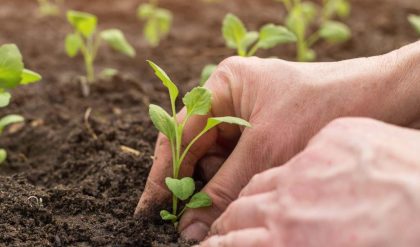Sensors
A sensor is a device used to measure some quantity of interest and produce a signal (usually electrical) representing that measurement.
Sensor types
A variety of sensor types have been developed to measure many different phenomena of interest to agriculture. Strain gage sensors measure micro deflections of surfaces to which they are glued. Because deflections are caused by forces, strain gages can be used to measure forces and pressures as well as deflections. Piezoelectric sensors are crystals that produce an electrical signal when subjected to stress. Ionselective field effect transistors (ISFETs) are sensors that can measure concentrations of chemical substances. They utilize special membranes that generate a differential charge while selectively passing ions; the membrane is coated on a field effect transistor to generate a useable signal. For example, an ISFET that selectively passed nitrate ions could measure nitrate concentrations in a soil-water slurry. Vision sensors use a digital camera to continuously capture images and then use image analysis software to continuously capture useable information from the images.
Sensor applications
Detailed analysis of the various sensors is beyond the scope of this book. Sensor development has become a critical need for the continued advance of SSCM. The ASABE technical library includes more than 1,000 web-accessible documents that relate to sensor development. Sensors in existence or under development are aimed at the following measurements supporting SSCM:
Ø soil moisture
Ø soil air permeability
Ø crop moisture content (grain, forage, etc.)
Ø soil strength
Ø crop flow rate into harvester
Ø concentrations of soil nutrients (grain, forage, cotton, etc.) (nitrates, potassium, etc.)
Ø soil surface profile
Ø quality of crop/grain into harvester (protein, oil, etc.)
Ø crop nitrogen stress
Ø weed sensor
Ø crop leaf area
Ø plant population
Ø flow rates of fertilizer, pesticides, etc. in an applicator
Advanced sensors
Miniaturization has allowed development of smart sensors, wireless sensors, and sensor fusion. A smart sensor is made by integrating a microprocessor with a sensor to produce a more useful signal. When using a differential pressure transducer to measure the pressure drop across an orifice, for example, the signal would vary linearly with the pressure differential but with the square root of the flow rate through the orifice (see Equation 5.9). Integrating a microprocessor into the transducer could produce a signal that varied linearly with the flow rate. Sensor fusion combines more than one sensor and a microprocessor into a single unit. Combining a grain moisture sensor with a flow rate sensor, for example, could produce a sensor that measured the grain flow rate on a dry weight basis. Finally, a wireless sensor incorporates a radio transmitter to allow the sensor data to be transmitted without a wire. Such a sensor could be very useful if installed on a rotating shaft or in other applications where use of wire connections would be very inconvenient.



